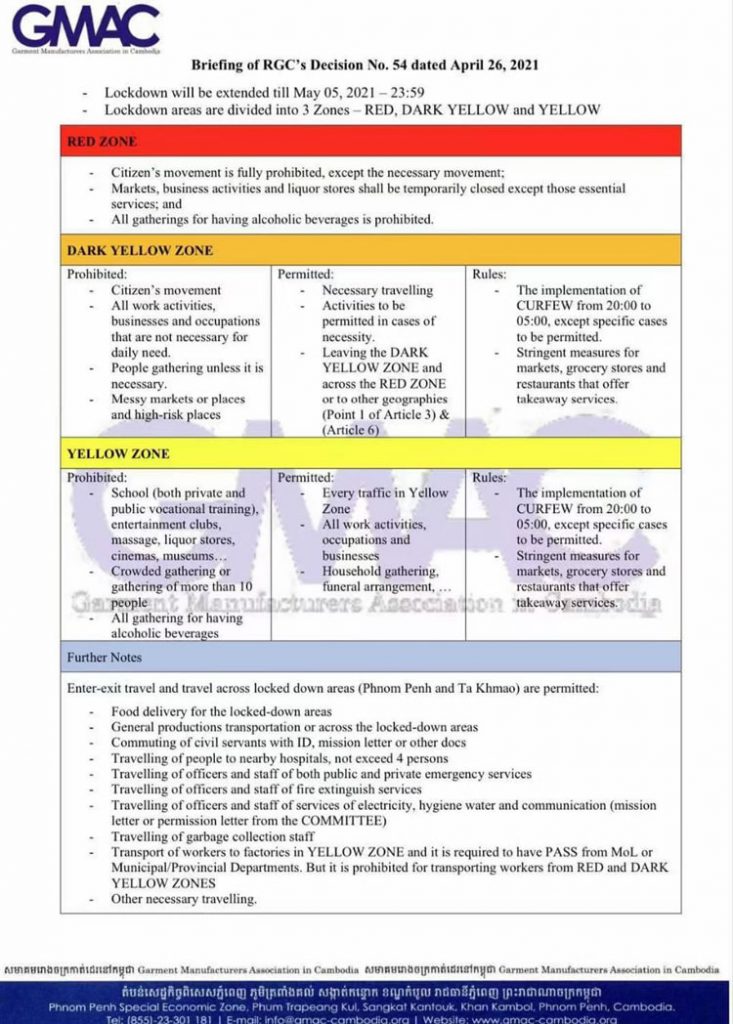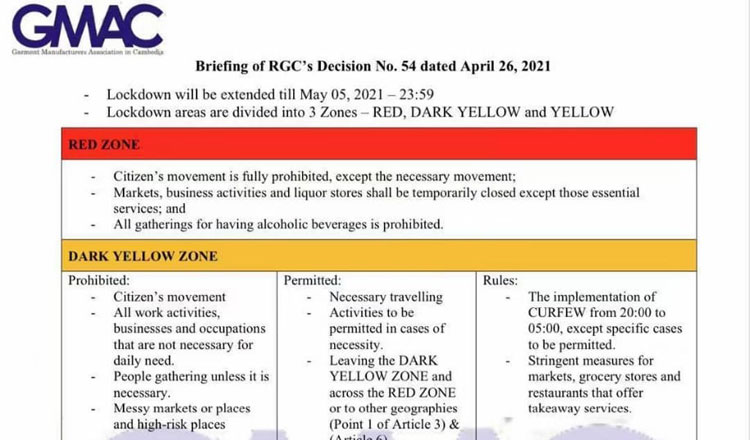Cambodia: Yellow Zone garment factories may re-open, but with caution
A document outlining the new colour-coded designations for city areas indicates that garment factories and other manufacturing facilities in Yellow Zones may be allowed to re-open in earnest by April 29.
“All work activities, occupations and businesses” are deemed “permitted” for those living and working in Yellow Zones, according to an outline detailing the COVID-affected restrictions.
Ken Loo, secretary-general for the Garment Manufacturers Association of Cambodia (GMAC), told Khmer Times, pending an official announcement, that his organisation has interpreted the statement to mean factories in Yellow Zones will be allowed to resume operations.
All garment factories in Phnom Penh and Takmao city, Kandal province, suspended operations earlier this month after thousands of workers were found to have contracted COVID-19.
“I hope that factories will be allowed to re-open, but I have not received any official directive from the government. The industry would welcome the news with open arms because the last year has been quite difficult for garment manufacturers. Some are facing the risk of not being able to meet purchase orders on time and possibly pay penalties because of that,” Loo said.

Workers living in Yellow Zones (areas with the least restrictions) may resume working. However, those in Orange Zones (those with moderate restrictions) and Red Zones will not be able to travel to and from work. Factories in these areas will also remain shut until at least May 5 – the extended date for lockdowns.
“Despite Cambodia having managed the pandemic extraordinarily well until the Feb 20 event, the garment industry is still reeling from a lack of orders coming in from overseas. People in Europe and North America are frequenting malls less and working from home. That means people are less likely to buy new clothes,” said Loo.
Earlier this week, GMAC issued a legal advisory that urged employers to provide stipends for workers during factory closures.
“Employers are encouraged to provide an allowance that can be any portion or all of a worker’s/employee’s wages according to their ability and this should be considered and implemented during the contract suspension in the spirit of humanity, solidarity and social responsibility,” the advisory read.
Loo said that given the circumstances, he had observed factories doing the best they can to take care of their employees. They are already required to continue providing accommodation or a financial allowance in its stead. However, larger factories that supply larger purchase orders are better equipped to handle the request.
“I can say that everyone is having trouble, from the owners to the employees. GMAC is working closely with authorities and stakeholders to ensure that the garment sector is revived after the global slowdown. The fashion industry generally seeks the lowest cost with the highest productivity so perhaps countries such as Bangladesh or Sri Lanka will bounce back faster and better than Cambodia,” said Loo.
GMAC has previously lobbied the government to reduce overheads for garment factories, including reducing the cost of electricity, limiting the number of holidays and advising that minimum wage increases keep the sector competitive with other garment manufacturing bases.
In January, Cambodia increased its minimum wage by $2 to $192 per month, one of the lowest increases in nearly a decade. The monthly minimum wage has nearly doubled since 2014 when it was $100 per month.
Rival garment manufacturing countries such as Bangladesh offer about $100 monthly, while Sri Lanka offers approximately $50.
Source: https://www.khmertimeskh.com/50846999/yellow-zone-garment-factories-may-re-open-but-with-caution/


 Thailand
Thailand




